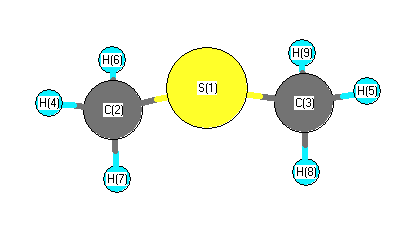Vibrational Frequencies calculated at CCSD(T)/cc-pVQZ
| Mode Number |
Symmetry |
Frequency
(cm-1) |
Scaled Frequency
(cm-1) |
IR Intensities
(km mol-1) |
Raman Act
(Å4/u) |
Dep P |
Dep U |
|---|
| 1 |
A1 |
3143 |
3048 |
|
|
|
|
| 2 |
A1 |
3036 |
2944 |
|
|
|
|
| 3 |
A1 |
1493 |
1448 |
|
|
|
|
| 4 |
A1 |
1368 |
1327 |
|
|
|
|
| 5 |
A1 |
1055 |
1023 |
|
|
|
|
| 6 |
A1 |
713 |
691 |
|
|
|
|
| 7 |
A1 |
264 |
256 |
|
|
|
|
| 8 |
A2 |
3125 |
3030 |
|
|
|
|
| 9 |
A2 |
1470 |
1426 |
|
|
|
|
| 10 |
A2 |
958 |
929 |
|
|
|
|
| 11 |
A2 |
181 |
176 |
|
|
|
|
| 12 |
B1 |
3117 |
3023 |
|
|
|
|
| 13 |
B1 |
1480 |
1435 |
|
|
|
|
| 14 |
B1 |
993 |
962 |
|
|
|
|
| 15 |
B1 |
185 |
179 |
|
|
|
|
| 16 |
B2 |
3144 |
3048 |
|
|
|
|
| 17 |
B2 |
3040 |
2948 |
|
|
|
|
| 18 |
B2 |
1486 |
1441 |
|
|
|
|
| 19 |
B2 |
1345 |
1304 |
|
|
|
|
| 20 |
B2 |
915 |
887 |
|
|
|
|
| 21 |
B2 |
767 |
744 |
|
|
|
|
Unscaled Zero Point Vibrational Energy (zpe) 16637.8 cm
-1
Scaled (by 0.9697) Zero Point Vibrational Energy (zpe) 16133.7 cm
-1
See section
III.C.1 List or set vibrational scaling factors
to change the scale factors used here.
See section
III.C.2
Calculate a vibrational scaling factor for a given set of molecules
to determine the least squares best scaling factor.
